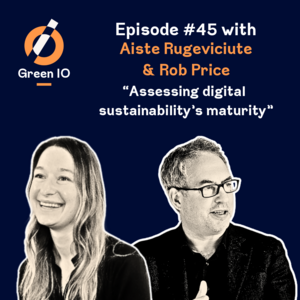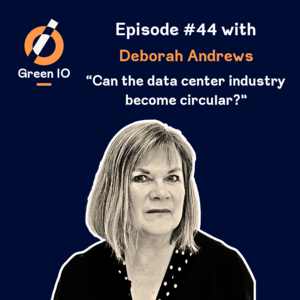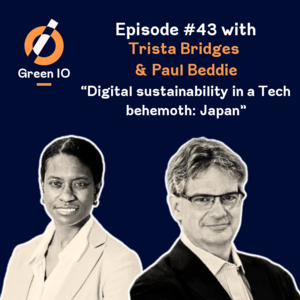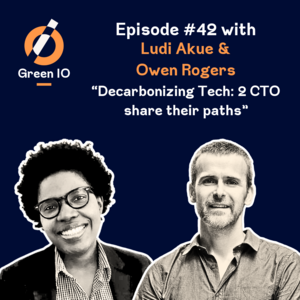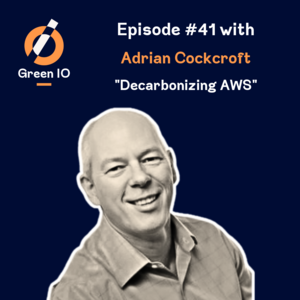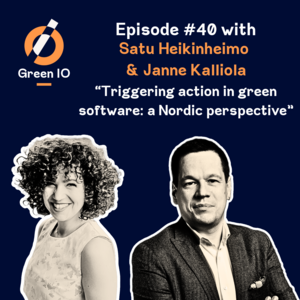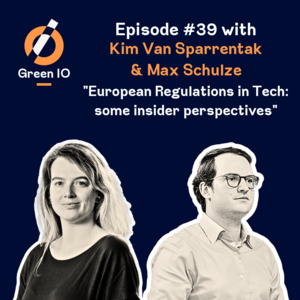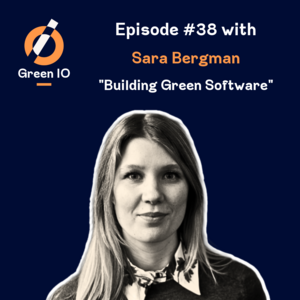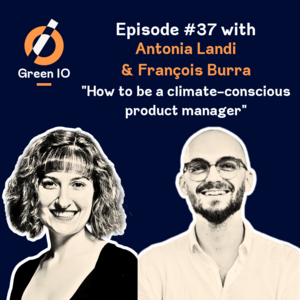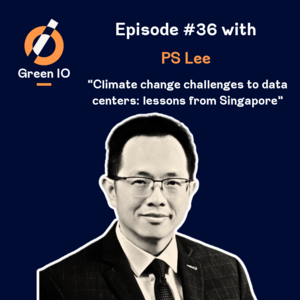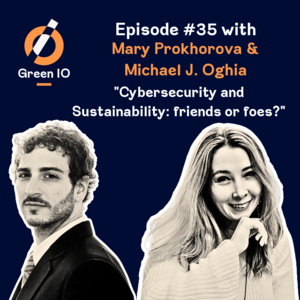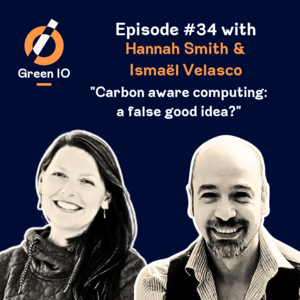#30 - Can Digital Marketing be low-carbon? with Audrey Danthony and Diarmuid Gill
Update: 2023-12-19
Description
0.9g of CO2e. It’s pretty ridiculous when you think about it. According, the French SRI association this is the carbon footprint for a 10K prints digital campaign with a 200k image. So not a big deal?
Not that simple because we’re talking about volumes in trillions per day here. So maybe it’s a good idea to dive a little deeper on the environmental impact of digital marketing after all.
Hence we brought 2 experts in AdTech with a soft spot for Sustainability: Diarmuid Gill is Criteo’s CTO since 2019 and has been in Digital Advertising for more than 15 years. Audrey Danthony has also a long career in AdTech, she started her first company, Oxeva, during the dot-com boom when she was still a student at engineering school. And 2 years ago she pivoted and founded with 2 partners Impact+ with the aim of reducing Greenhouse Gas emissions in digital advertising.
Not that simple because we’re talking about volumes in trillions per day here. So maybe it’s a good idea to dive a little deeper on the environmental impact of digital marketing after all.
Hence we brought 2 experts in AdTech with a soft spot for Sustainability: Diarmuid Gill is Criteo’s CTO since 2019 and has been in Digital Advertising for more than 15 years. Audrey Danthony has also a long career in AdTech, she started her first company, Oxeva, during the dot-com boom when she was still a student at engineering school. And 2 years ago she pivoted and founded with 2 partners Impact+ with the aim of reducing Greenhouse Gas emissions in digital advertising.
Learn more about our guests and connect:
📧 You can also send us an email at greenio@duez.com to share your feedback and suggest future guests or topics.
Audrey's and Giarmuid's sources and other references mentioned in this episode:
- IAB Europe
- NegaOctet database
- Criteo
- Impact+
- MCJ’s episode with Netflix CSR Emma Stewart
- 55' study on the carbon footprint of media campaign
- Dimpact
- Scope3
- Solitaire Townsend’s TED talk: Are ad agencies, PR firms and lobbyists destroying the climate?
Transcript
[00:00:00 ] Gaël: Hello, everyone. Welcome to Green IO, the podcast for responsible technologists, building a greener digital world, one byte at a time. Our guests from across the globe share insights, tools and alternative approaches, enabling people within the tech sector and beyond to boost digital sustainability. And before we start, I would like to thank the hundreds of Green IO listeners who joined the first Green IO conference in Paris on December the 8th.
[00:00:29 ] Gaël: It was great to see so many of you and the discussions covered a wide range of topics, as well as the feedback shared. Get ready for more conferences in 2024 because we will come back to Paris in December, but we will also launch our first Green IO London conference September 17th and 18th, and we might have one in Singapore as well if we have enough traction there. Ping me if you're interested to talk or to partner in any of these three conferences.
[00:00:58 ] Gaël: 0. 9 grams of CO2 equivalent. It's pretty ridiculous when you think about it, and that was a result I got after playing with a calculator based on the French SRI association methodology for a 10k prints digital campaign with a 200k image. 0.8 actually with a French energy mix which is quite low carbon, so not a big deal, I guess?
[00:01:24 ] Gaël: But not that simple. Because we're talking about volumes in trillions per day here. Moreover, in the past couple of years, several solutions have appeared on the market to tackle greenhouse gas emissions from digital media companies, like Scope 3, the Dimpact framework, and Impact Plus solution, to name just a few.
[00:01:46 ] Gaël: And the potential savings in GHG emissions they promote are significant. So maybe it's a good idea after all, to dive a little deeper on the environmental impact of digital marketing. Hence, I decided to bring two experts in from tech with a soft spot for sustainability to enlighten us. Diarmuid Gill is Criteo's CTO since 2019 and has been in digital advertising for more than fifteen years. He even worked at AOL, remember?! And today at Criteo, he is in charge of serving more than, I guess, five billion, so quite a tech stack behind it and some carbon emissions involved.
[00:02:30 ] Gaël: Audrey also has a long career in IT. She started her first company Oxeva during the dot.com boom when she was still a student at engineering school. And two years ago she piloted and founded, with two partners, Impact +, with the aim of reducing greenhouse gas emissions of digital advertising. They already have several global brands as clients, starting with L’Oréal or Heineken.
[00:02:54 ] Gaël: And for the record, Audrey used to live in the Reunion Island where we met, and we have had multiple occasions of discussing life cycle analysis, the subtlety of brand campaign versus reach campaign and so much more. So welcome Audrey and Diarmuid, thanks a lot for joining Green IO today.
[00:03:18 ] Diarmuid: The pleasure is mine. So, before we deep dive in how to measure, how to reduce, what is the momentum in our digital marketing industry, how can carbon emissions be measured from digital advertising, and why does it matter? Maybe Audrey you want to share some thoughts on it?
[00:03:39 ] Audrey: Yes, with pleasure. So as with any product and service, it's perhaps more convenient to speak about evaluation than measurements, because everything we evaluate about these impacts are based on models, and most of them are based on the principle of life cycle assessments methodologies. So when it comes to evaluating the impacts of digital services, the idea is to take into account three tiers. The first one is about the servers which are used to deliver an ad. The second tier is the devices, the end user devices, used by the end user, the client itself who will see the ad. And the third tier are the networks which are used to deliver the ad through the servers to the end user.
[00:04:36 ] Audrey: A lot of digital services tend to focus on only the impact of the servers themselves, but it's really important to take in account these end user devices because according to a Green IT report, more than 40 of these impacts are due to the mining, the manufacturing, the transportation of the servers, the routers, but also the end user devices.
[00:05:00 ] Audrey: So that's a very huge part of this. But when it comes to evaluating all these impacts, we take in account not only this life cycle part, meaning the manufacturing of the devices, but also the carbon emissions due to the electricity used by the servers, networks, and end user devices. The idea is to evaluate this electricity consumption and combine this with what is named the carbon intensity of electricity.
[00:05:32 ] Audrey: It's how much emissions are due to the production of one kilowatt of electricity. And this can depend on the electricity grid of a single country meaning that in France, it's low because of the nuclear plants that are used in our country, but in other countries that could be much higher, because, for example, in Asia, a big part of the electricity can be produced with coal plants.
[00:05:58 ] Gaël: And what about digital advertising itself? Can you share with us an order of magnitude? How many tons are we talking about?
[00:06:07 ] Audrey: So, what you must take into account and what you have already mentioned is that it's a question of volumes. The global digital ad spends is a market of about 700 billion dollars per year.
[00:06:23 ] Audrey: This represents trillions of ads delivered every day. This also represents something like 70 percent of the total advertising investment in the world. Digital advertising has been evaluated as much as 60 million round trips from London to New York by plane. And that's the total, the same total emissions of a country like Ireland. So that's a huge volume of emissions.
[00:06:57 ] Gaël: And just to keep on understanding the landscape Iwould say, before deep diving on more concrete solutions, who are you talking to ? Diarmuid, same question for you. Actually, maybe Diarmuid first, because I’m very happy to have a CTO around the table to discuss this, but I had a conception, which is maybe a misconception, that this topic was mostly followed by chief marketing officer or chief sustainability officer, and that was not that much a tech or product led topic. So, who are you folks mostly talking to when you're discussing this carbon footprint of digital advertising?
[00:07:43 ] Diarmuid: Okay, well starting from the point of view of Criteo and from my perspective, I've been CTO since 2020, and people who I talk to most about sustainability are actually employees
Comments
Top Podcasts
The Best New Comedy Podcast Right Now – June 2024The Best News Podcast Right Now – June 2024The Best New Business Podcast Right Now – June 2024The Best New Sports Podcast Right Now – June 2024The Best New True Crime Podcast Right Now – June 2024The Best New Joe Rogan Experience Podcast Right Now – June 20The Best New Dan Bongino Show Podcast Right Now – June 20The Best New Mark Levin Podcast – June 2024
In Channel






